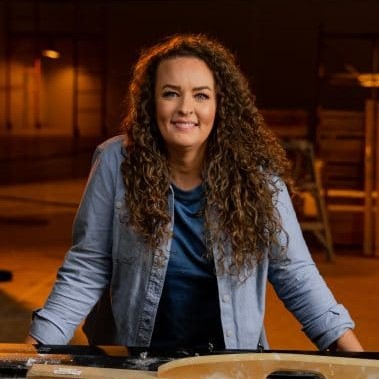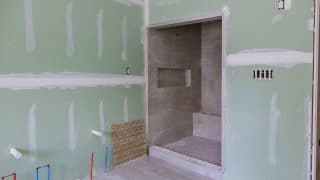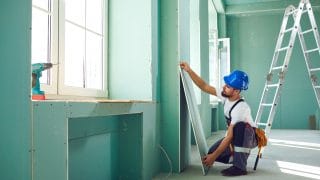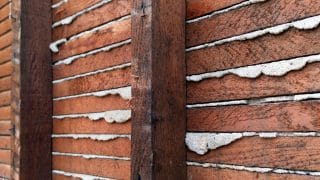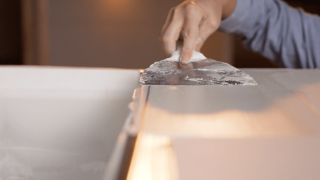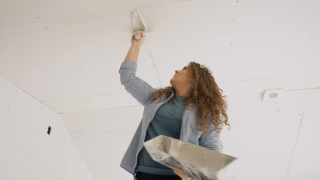Pursuing a drywall finisher career allows you to become an important contributor to new construction and renovation projects. The process involves creating smooth and even walls that give a clean and crisp look to any space. Drywall finishers work in both residential and commercial settings, providing a range of potential projects to be a part of. Learn what to expect on the job as a drywall finisher and how to qualify for openings in your area.
What is drywall finishing?
Drywall finishing involves three stages to get a final product installed on walls, ceilings, or building partitions. Here are the primary responsibilities you’ll take on as a drywall finisher.
Mudding
Finishing typically doesn’t involve cutting and hanging the drywall pieces — that’s done by the drywall installer. Instead, you’ll focus on creating a smooth texture that’s ready to paint. The first step is to use hot mud to fill gaps and joints while covering screws throughout the pieces of drywall. Ultimately, the goal is to achieve a flat finish without any aberrations.
Taping
Tape is used over the mud to cover the seams between two adjoining sheets of drywall. Finishers roll mesh tape over the mud to smooth out the surface and strengthen the joints. It’s especially important in corners to safely secure both drywall pieces. Once the tape is set in place, you’ll wipe off the excess mud.
Coating
The final step of finishing drywall is to coat the tape with topping compound after the mud dries. The required number of coats depends on what type of finishing level you’re trying to achieve. There are five levels to choose from, each of which has its own degree of smoothness. A level 1 finish, for instance, is reserved for functional areas like garages. A level 5 finish, on the other hand, requires four coats and gives the most even look out of all the options.
What does a drywall finisher do?
There are several skills involved in a drywall finishing career. It’s a physically demanding job that may include new installation as well as fixing damaged walls and ceilings in existing spaces. You’ll likely need to learn how to read blueprints in order to understand what needs to be done for each job.
Throughout the project, mudding is usually done with a hand trowel and involves going up and down ladders (and potentially even scaffolding) to reach all the areas of drywall that need to be addressed. There are some tools, however, that put out the mud and tape at the same time, making the process go by more quickly. When coating, you’ll need to sand and reapply as needed to get the desired finish leve.
Pursuing a drywall finisher career allows you to become an important contributor to new construction and renovation projects. The process involves creating smooth and even walls that give a clean and crisp look to any space. Drywall finishers work in both residential and commercial settings, providing a range of potential projects to be a part of. Learn what to expect on the job as a drywall finisher and how to qualify for openings in your area.
What is drywall finishing?
Drywall finishing involves three stages to get a final product installed on walls, ceilings, or building partitions. Here are the primary responsibilities you’ll take on as a drywall finisher.
Mudding
Finishing typically doesn’t involve cutting and hanging the drywall pieces — that’s done by the drywall installer. Instead, you’ll focus on creating a smooth texture that’s ready to paint. The first step is to use hot mud to fill gaps and joints while covering screws throughout the pieces of drywall. Ultimately, the goal is to achieve a flat finish without any aberrations.
Taping
Tape is used over the mud to cover the seams between two adjoining sheets of drywall. Finishers roll mesh tape over the mud to smooth out the surface and strengthen the joints. It’s especially important in corners to safely secure both drywall pieces. Once the tape is set in place, you’ll wipe off the excess mud.
Coating
The final step of finishing drywall is to coat the tape with topping compound after the mud dries. The required number of coats depends on what type of finishing level you’re trying to achieve. There are five levels to choose from, each of which has its own degree of smoothness. A level 1 finish, for instance, is reserved for functional areas like garages. A level 5 finish, on the other hand, requires four coats and gives the most even look out of all the options.
What does a drywall finisher do?
There are several skills involved in a drywall finishing career. It’s a physically demanding job that may include new installation as well as fixing damaged walls and ceilings in existing spaces. You’ll likely need to learn how to read blueprints in order to understand what needs to be done for each job.
Throughout the project, mudding is usually done with a hand trowel and involves going up and down ladders (and potentially even scaffolding) to reach all the areas of drywall that need to be addressed. There are some tools, however, that put out the mud and tape at the same time, making the process go by more quickly. When coating, you’ll need to sand and reapply as needed to get the desired finish leve.
Most drywall finishers work full-time during weekdays. According to the BLS, the median pay for 2020 was over $59,000 a year. This specialization pays better than an installer’s salary, which averages around $48,000 per year. The 10-year job outlook for finishers is stable as older workers retire from the industry.
How to become a drywall finisher
While there is no requiremented trainig in order to become a drywall finisher, there are a few ways you can educate yourself to get ahead in the job market.
- High school diploma. Employers usually want trainees to have a high school diploma or GED before enrolling in a training program for finish work. Math and shop classes are smart options to focus on if you’re still working on this step.
- Apprenticeship program. Before you can start working as a full-time drywall finisher, you will likely need to complete either an apprenticeship program or a trade school certification. With an apprenticeship program, you’ll spend two to three years training under an experienced finisher. The position is paid and could lead to a permanent job. Look for apprenticeship programs at construction companies or through unions.
- Trade school. Another option is to enroll in a two-year trade school program. This isn’t required, but the extra certification or associate’s degree could help you climb the career ladder over time, or set you up to start your own business. There may not be a specific drywall program available, but you could focus on a broader general contractor tract and still get the skills you need to succeed as a finisher.
Final thoughts
Becoming a drywall finisher gives you the chance to follow an engaging career path that takes you to a range of work environments. It’s an ideal option to think about for people who love to be active throughout the day and have keen attention to detail.
MT Copeland offers video-based online classes that give you a foundation in construction fundamentals with real-world applications, like drywall finishing. Classes include professionally produced videos taught by practicing craftspeople, and supplementary downloads like quizzes, blueprints, and other materials to help you master the skills.

